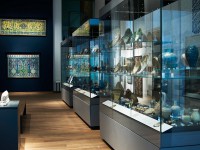Room 31 | Islamic Middle East gallery
Explore artefacts made over a period of more than 1000 years in the heart of the Islamic world.

In its early years, the new Islamic empire faced a formidable challenge: to develop a visual identity that would distinguish it from its religious and political rivals.
Both the Byzantines, who ruled over the Mediterranean, and the Sasanians of Iran had developed an elaborate imagery to express political and religious messages. These images were used to decorate buildings and monuments as well as coins, which were the most effective medium for the ruler to transmit messages to his subjects.
After a period of imitation and adaptation of Byzantine and Sasanian models, in the late AD 690s, the Caliph Abd al-Malik chose to abandon figural representation on coins in favour of Arabic script.
Early Islamic coins imitated those in use in the Sasanian (HCR7444) and Byzantine (HCR6313) empires, modifying some of their elements and adding inscriptions in Arabic, like the formula bism Allah (In the name of God) (HCR7445, HCR7443) and the Shahada, the Islamic profession of faith (There is no god but God alone, Muhammad is the Prophet of God) (HCR7443-HCR4812).
From the late AD 690s, images disappeared from Islamic coins. They were replaced with inscriptions including the Shahada and verses of the Qur'an expressing the fundamental beliefs of Islam. From the AD 760s onwards, Islamic coins began to name the person under whose authority they were struck (HCR7448, HCR7449 & HCR7450).
Notice
Objects may have since been removed or replaced from a gallery. Click into an individual object record to confirm whether or not an object is currently on display. Our object location data is usually updated on a monthly basis, so contact the Jameel Study Centre if you are planning to visit the museum to see a particular Eastern Art object.
© 2013 University of Oxford - Ashmolean Museum










